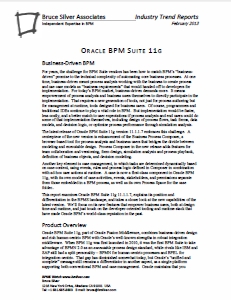For years, the challenge for BPM Suite vendors has been how to match BPM’s “business-driven” promise to the technical complexity of automating core business processes. At one time, business-driven meant process analysts working with the business to create process and use case models as “business requirements” that would handed off to developers for implementation. For today’s BPM market, business-driven demands more. It means empowerment of process analysts and business users themselves to directly participate in the implementation. That requires a new generation of tools, not just for process authoring but for management at runtime, tools designed for business users. Of course, programmers and traditional IDEs continue to play a vital role in BPM. But implementation would be faster, less costly, and a better match to user expectations if process analysts and end users could do some of that implementation themselves, including design of process flows, task forms, data models, and decision logic, or optimize process performance through simulation analysis.
The latest release of Oracle BPM Suite 11g version 11.1.1.7 embraces this challenge. A centerpiece of the new version is enhancement of the Business Process Composer, a browser-based tool for process analysts and business users that bridges the divide between modeling and executable design. Process Composer in the new release adds features for team collaboration and versioning, form design, simulation analysis and process playback, definition of business objects, and decision modeling.
Another key element is case management, in which tasks are determined dynamically based on case context, using events, rules and process logic defined in Composer in combination with ad-hoc user actions at runtime. A case is now a first-class component in Oracle BPM 11g, with its own model of case activities, events, stakeholders, and permissions separate from those embedded in a BPM process, as well as its own Process Space for the case folder.

















